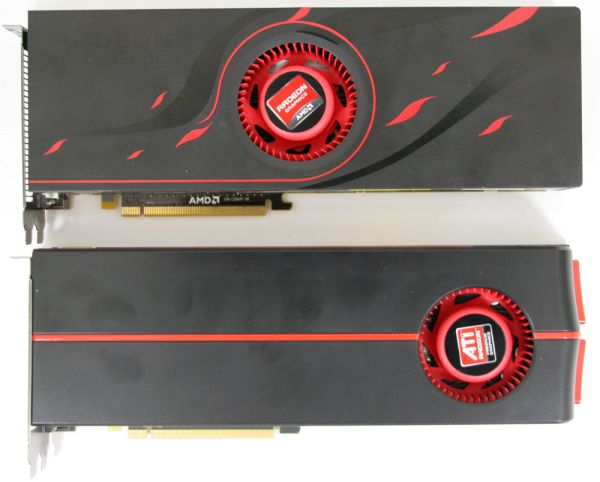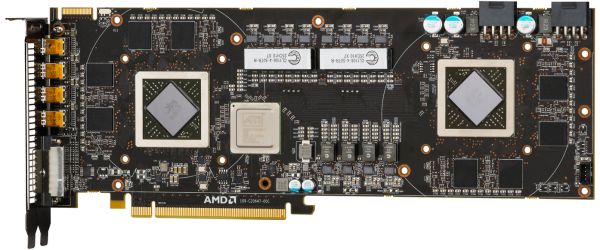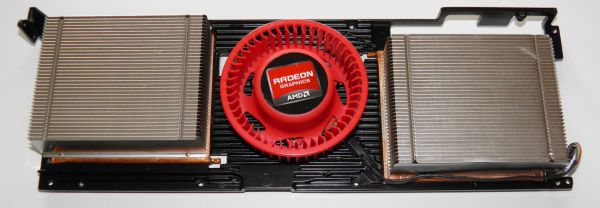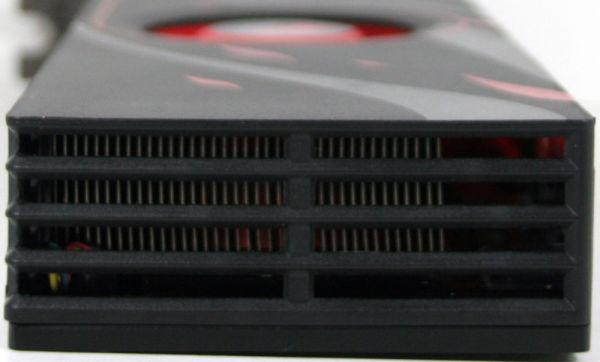AMD's Radeon HD 6990: The New Single Card King
by Ryan Smith on March 8, 2011 12:01 AM EST- Posted in
- AMD
- Radeon HD 6990
- GPUs
Meet The 6990
If you recall our coverage on the 5970, we found a few areas where AMD was lacking. The cooling on the 5970 was sufficient to run the GPUs even at 5870 clocks and voltages, however the cooling on the VRMs was lacking, leading to real world programs trigging the VRM thermal protection mechanism; and while this was within safety guidelines, it’s not a comfortable place to be for long term operation. This ultimately led to us writing off the 5970OC as a 100% reliable product, sticking to recommending the 5970 solely at stock speeds.
The design of the 6990 in turn reads very much like a response to our findings in true engineering fashion. Furthermore for the 6990 AMD not only had to take a look at the 5970’s weaknesses, but also how to handle an even greater power load. The result is that the 6990 is distinctly different from the 5970 before it.
Compared to the 5970, the 6990 is ever so slightly shorter, thanks in large part to the fact than the 6000 series casing is more squared off compared to the 5000 series’ tapered design. As a result it comes in at 11.5” for the PCB (the same as the 5970), and with casing a full 12” long compared to the 5970’s 12.16”. This means that the 6990 has effectively the same space requirements as the 5970, cooling notwithstanding.
Meanwhile it’s the fan however that is going to catch the most attention and this is where we’re going to dovetail in to cooling. The 5970’s traditional blower had its strengths and weaknesses, the strengths being that blowers are relatively forgiving about a case’s ability to exhaust hot air, and the weaknesses being that the GPU (and VRMs) closest to the fan received better cooling than the farther GPU. The VRMs proved to be particularly problematic, as they could overheat well before the GPUs did and AMD does not spin up their fans based on VRM temperatures.
Correcting for this and at the same time allowing for even greater heat dissipation, the rear blower design is out. Its replacement is a design that we’ve seen in 3rd party cards before such as the Asus ARES 5870X2, but not in a reference design: a center-mounted fan/blower with a GPU to each side. The difference is critical and indeed cannot be understated: a rear blower channels most hot air outside of the case, while a center-mounted blower effectively splits the card in two, with one GPU + supporting chips being exhausted outside of the case, and the 2nd GPU + supporting chips being exhausted inside the case. The design is still enclosed, so everything goes out either the front or back of the card while fresh air is pulled in the center.
With the replacement of the blower, so has gone the heatsink. The 5970’s single large vapor chamber + heatsink design has been replaced in favor of a segmented heatsink, further driving home the concept that the 6990 is closer to 2 video cards sharing 1PCB than it is 2 GPUs on one card. Each heatsink in turn is connected to the GPU via its own vapor chamber, resulting in the GPUs being fully isolated from each other as far as cooling is concerned.
Even the thermal paste connecting the GPUs to the vapor chambers has been changed for the 6990 – AMD has replaced traditional paste with a phase change material. Phase change materials – pastes/pads of material that melt and solidify based on temperature are nothing new, however they’re still exotic; material similar to what AMD is using is not readily available as paste is. AMD even went so far as to suggest that reviewers not directly disassemble their 6990s as it would require a new application of phase change paste in order to achieve the same efficiency as the original material. The net result of all of this by AMD’s numbers is that the phase change material is 8% better than the regular paste they’ve been using.
Rounding out our focus on cooling is the VRMs, which have been relocated in order to correct for the 5970’s limited VRM cooling capabilities. The VRMs and controllers are now at the center of the board – now they’re cooled before the GPUs or RAM modules are. The profoundness of this is twofold: not only is it an improvement on the 5970, but with the 6990’s higher power consumption VRM cooling is even more important. As with the 6970, voltage regulation is supplied by Volterra MOSFETs and controllers.
All told, while the 5970 was designed to handle and dissipate 400W of heat, the 6990 is officially designed for 450W. In practice, at its limits in our test rig this is closer to 500W. To handle and dissipate that much heat in roughly 72in3 of space is nothing short of amazing.


















130 Comments
View All Comments
Figaro56 - Tuesday, March 8, 2011 - link
I have 2 XFX HD 5870 cards for sale. I have a double lifetime warranty on these so you get the use of the second lifetime warranty on these. Interested? They are very great performers I can vouch for that. I am use to upgrading my GPU on an annual basis so I am upgrading to 2 HD 6970. $230 each.Thanny - Tuesday, March 8, 2011 - link
Ignoring the inappropriateness of advertising here, I submit:http://www.newegg.com/Product/Product.aspx?Item=N8...
Why would someone pay you $230 for a used product that can be obtained new at $190?
fausto412 - Tuesday, March 8, 2011 - link
I kinda wanted to see a chart with the most common gaming resolution...and can we benchmark with a Q9550 just for comparison? i would love to know if i'm holding back a video card by not going i5 or i7 and by how much.jabber - Tuesday, March 8, 2011 - link
If you can afford a 6990 why would you be bothering using it with a Q9550 at 1680x1050. Hence why it isnt part of this review.This review is to show how it works for the intended market/customer.
As I said before, this card isnt for folks like you (or me for that matter). Sorry.
7Enigma - Tuesday, March 8, 2011 - link
The most common gaming resolution for this card is the one Ryan tested. It is pointless to test at a lower resolution other than possibly true 24" (1920X1200). And even at that res this card is really not needed.Figaro56 - Tuesday, March 8, 2011 - link
BOYA to both of those resolutions. You should be playing your games at 2560x1600. Now that's what I'm talkin about! You'd be saying hell ya.Jorgisven - Tuesday, March 8, 2011 - link
It seems we're getting into the Pentium IV trap, a bit. Big, hot, power-hungry, noisy chips...personally, I'm going to pass on this generation of GPUs. I'm waiting for a revolution in either manufacturing or coding. It's all well and good to have a fast computer for getting what you need done in minimal, but at the risk of the box taking flight because the fans are now of jet engine proportion in speed and power, I'd rather not be able to hear my fans over my headphones...or risk my cat getting sucked into the intake.jabber - Tuesday, March 8, 2011 - link
Well we've kinda got what we asked for. We've all gamely been buying more and more powerful graphics cards with regards to brute force rendering power.We've shown we love buying 750w+ power supplies with multiple GPU connectors, buying SLI and Xfire setups galore.
So the GPU corps think we love nothing more than just piling on more and more power and wattage to solve the situation.
It works both ways.
What we should have been doing was challenging AMD and Nvidia to develop smarter rendering techniques. Had either of them developed PowerVR to the state we are in today we would be in a far better place. Chances are the most power hungry card we'd have today would be 5770 level.
We need something more efficient like PowerVR to take us to the next level.
Less brute force and more finesse.
therealnickdanger - Tuesday, March 8, 2011 - link
Are you waiting to update your test system until the SATA port issue is corrected? Seems to me that anyone wanting to buy this card would also be using an overclocked 2600K... According to the Bench numbers, the 2600K offers roughly 30% more frames than the 920, depending on the game. That indicates to me that your test system is insufficient to properly test this card.Granted, since the vast majority of displays are fixed at 60Hz, fps counts beyond that don't really matter, but I have to wonder what impact this would have on folks with 120Hz-native LCDs. That extra 30% could make the difference.
... just sayin'. :)
Ryan Smith - Tuesday, March 8, 2011 - link
At this point we're waiting on SNB-E. SNB is very nice, but for a GPU testbed the lack of PCIe bandwidth is an issue.